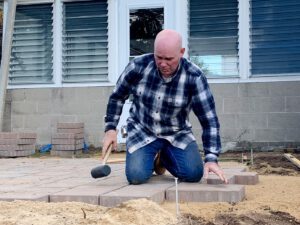If you are looking to redo your outdoor area, you might be wondering how to properly install Pavers. There are many steps involved in this process, including grading, compaction of the sub-base, sand preparation, and paver installation. When the paver installation is completed properly, uneven surfaces are rarely a problem. Unlike concrete pavement, pavers can be readjusted if they shift or settle. A motorized plate compactor sets the pavers into place. Additional sand is then swept across the surface, filling joints, and compacting the surface into a monolithic structure.

Before installing pavers, consider how you will use them. Pavers come in a variety of materials and can be used for both indoor and outdoor applications. In addition to being durable and easy to maintain, they are environmentally friendly as they are made from recycled tires. However, they lack the beauty and elegance of stone pavers. Rubber is an eco-friendly option, but it is less expensive than stone and does not retain as much heat as stone does.
Brick is one type of paver that is commonly used for outdoor areas. It is usually rectangular but custom shapes can be made upon request. They are relatively easy to install due to the lack of interlocking designs. A brick’s red color is achieved by a natural mineral called iron oxide. Since brick is a natural stone, it retains its color for a long time. Flagstone is a sedimentary rock used as thin tiles. It is not recommended for high-traffic areas, but it is suitable for garden paths, patios, and walkways.
There are thousands of different styles and colors to choose from. The combination of pavers will depend on your personal preferences and the aesthetics of your home. Many paving stones come in earth tones, although you can also find those that contrast with dominant colors such as blue or orange. You can even choose pavers that resemble weathered stone or antique cobble. And you can even create custom-shaped pavers to match your house’s exterior.
Concrete slabs are less flexible than pavers when it comes to durability. Pavers can be replaced individually, so if one breaks, you don’t have to replace the entire paver. In addition, concrete slabs are more likely to crack under foot and vehicle traffic, whereas pavers can withstand upwards of 8,000 PSI. Consequently, they last for decades and will not crack or split under high-traffic areas. They can handle up to four times more weight without cracking.
Segmental pavers have been around for thousands of years. In ancient Rome, pavers made of real stone and clay products were used to build streets. Before the mid-1940s, they were usually made of clay. Then, as the material for pavers improved, they were made of real stone. Until the mid-1940s, however, concrete pavers were mostly made of clay. For this reason, they were much more durable than pavers made of real stone.
Pavers are a great choice for exterior paving because they are durable and beautiful. In addition to their affordability, they also add curb appeal. They are also available in dozens of colors and styles, so you’re bound to find one that works with your home’s style. For example, flagstone and fieldstone are both beautiful and durable. They don’t fade easily, even when exposed to high-traffic areas. Moreover, unlike concrete, pavers can be made of many different types of stone. Flagstone and fieldstone are the most common types of outdoor pavers, but if you’d like something more rustic, consider limestone or travertine. These stones are durable and rarely need to be cleaned.
Pavers are affordable, durable, and extremely versatile. They can be used for driveways, patios, and pathways, as well as retaining walls and raised beds. They also add aesthetic appeal to any area and can conceal minor imperfections. If used properly, they can enhance your home’s look and make it much more attractive. You can even use pavers to disguise minor blemishes in your yard. If you have a hard time laying pavers, you can purchase pre-made pavers and install them yourself.
While concrete requires routine maintenance, pavers can be easily replaced if needed. If damaged bricks are removed, you can simply replace them with new ones. Another problem with pavers is tree roots. These can lift them, but they can easily be cut and replaced. If the underlying soil shifts and the paver’s base shifts, you can simply reinstall them. While pavers may be expensive, they can also last for decades, so you should invest in a quality set.